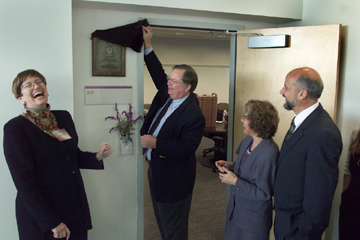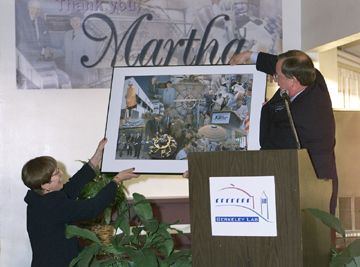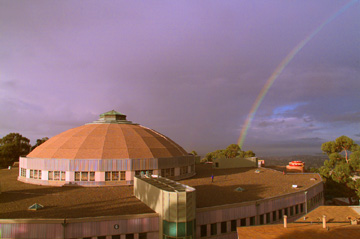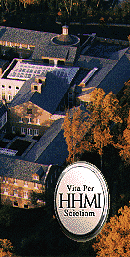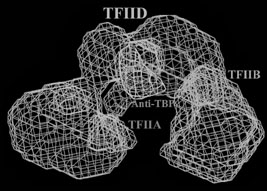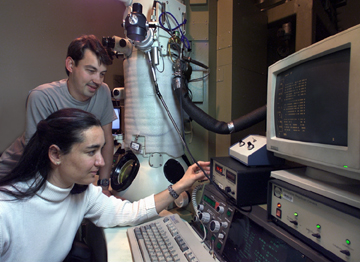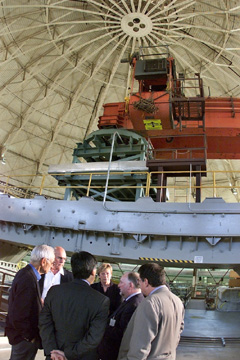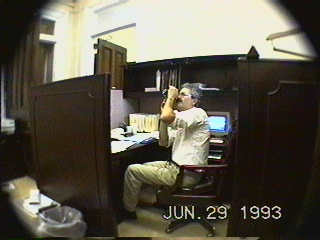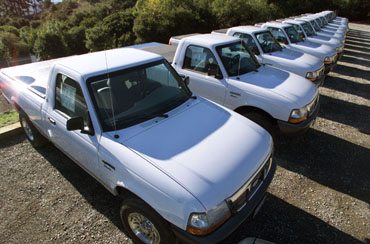
| Lab Honors Martha Krebs | $8 Million for the ALS Largest Ever Investment in the Lab's Advanced Light Source |
- Lab Team Reveals Structure of Key Protein Complex
- Lab Closes For the Holidays
- Washington Report
- Secretary's Advisory Board Tours ALS
- Elements 118, 116 Score Rare Double
- DOE Plan Limits Polygraph Tests to 800
- Berkeley Lab Currents
- Lab Contributes to White House Energy Savings Project
- How to Win an R&D Award: It's Not Rocket Science
- Call for Year 2000 Nominations
- Call for Discover Magazine Awards For Technological Innovation
- Lab Employees Make SHARES a Success
- Human Resources Addresses Staffing Issues in Benefits
- Bulletin Board
- Calendar of Events
- Holiday Shutdown Information
- UC Berkeley and Local Cities Sponsor Bay Area Book Drive for Children
- Currents Online
- Flea Market
- Flea Market Policy
Lab Honors Martha Krebs
By Ron Kolb
Berkeley Lab Director Charles Shank reminded everyone of what a significant mark Martha Krebs left on this institution and its people. And then, with a flip of the velvet curtain, he unveiled the indelible mark the Laboratory would leave for her -- a plaque outside the conference room named after her.
This tribute -- the dedication of the Krebs Conference Room on the third floor of the Genome Sciences Building -- was one of many paid to Krebs on Dec. 2 as she made her last pass through Berkeley as the Department of Energy's director of the Office of Science. She retired this month after six years guiding the DOE's science programs in Washington.
|
|
"Martha brought a civilizing influence to me and my colleagues," said David Shirley who, as Laboratory director, hired Krebs in 1983. "[She] gradually led us into a mode where we could get substantial support for our research and for new initiatives. She brought finesse into our operations and our strategic planning."
He especially cited her work in helping to secure the Advanced Light Source for the Laboratory, bringing to management her valued perspectives as a former Congressional subcommittee staff director.
Alvin Trivelpiece, Krebs' predecessor at the DOE's Office of Energy Sciences and retiring director of Oak Ridge National Laboratory, praised her work as a "strong and forceful advocate for science. She's been a friend to science, to the laboratories, and to the entities we work with. [The Office of Science] is a helluva lot better than when she got there."
|
|
"I was a neophyte on government matters," Shank said, recalling the first time she took him on visits in Washington. "It was an interesting and astounding day. I realized you face extraordinary consequences if you don't understand how it all works."
He said he recommended against Martha's move to Washington in 1993. "I thought it was too tough," Shank told the audience. "But she proved to be the toughest of all."
When she had her chance to speak, Krebs said she was "thrilled" with all the attention, but she spent most of her time thanking the people at Berkeley for helping her succeed in her career. "Relationships happen in the context of a community," she said. "I really think about this [celebration] as you coming together for yourselves. What has happened here has been a joint effort."
She cited the help she received from people like Mike Chartock, head of Planning and Communications, and scientific leaders Mina Bissell, Elton Cairns and Sally Benson. "They taught me what the labs are good for besides physics," she said, "which gave me a better sense of what the Office of Science was all about -- an intersection of disciplines."
And in reflecting on her "special feelings" for the day, she told the listeners, "I just want to let you guys know that you never let me down, even when times were difficult for you. I have paid attention to Berkeley all this time. You had problems with the ALS; you turned it around. You made the NERSC transition happen. And the `accelerating universe' discovery was an extraordinary thing. You proved these things can only be done at a lab. I was very proud."
The feeling, Shank said, is mutual.
"Martha gave her heart and soul for the labs," the Director said. "She had a constancy of view, plus the ability to handle the political machinations of Washington. She became a very knowledgeable advocate for the whole laboratory system. She pushed the idea that `DOE does science.' She really cared. And we will miss her."
$8 Million for the ALS
Largest Ever Investment in the Lab's Advanced Light Source
By Lynn Yarris
|
|
The Howard Hughes Medical Institute (HHMI), a philanthropy and one of the world's leading biomedical research organizations, will spend $8.05 million for the construction and operation of two new "superbend" beamlines at Berkeley Lab's Advanced Light Source. The beamlines will generate the high-energy or "hard" x-rays that are ideal for protein crystallography research.
"The Hughes Institute is pleased to be teaming up with the Lawrence Berkeley National Laboratory," said Thomas R. Cech, the president-designate of HHMI who takes office on Jan. 1. "The need for more such state-of-the-art facilities is growing because of the unsurpassed power of x-ray crystallography. The detailed 3-D views of biomedically important molecules that this technique yields provide a powerful framework for understanding how molecules function and interact."
Said Berkeley Lab Director Charles V. Shank, "This is the single largest investment in the ALS ever made by an organization outside of DOE. It reflects the growing importance of x-ray crystallography as a critical tool for the biomedical research community, and recognizes the success and promise of the ALS in identifying and characterizing proteins."
As the Human Genome Project approaches completion, the next big steps are to identify the proteins that human DNA codes for and find out what those proteins do. The key to understanding a protein's function is to determine its three-dimensional structure, and x-ray crystallography -- using a synchrotron light source like the ALS -- is one of the main techniques for accomplishing this.
In x-ray crystallography, a beam of x-rays sent through a protein crystal creates a set of diffraction patterns that can be translated by computer into 3-D images with atomic-scale resolution.
The ALS houses one of the top experimental facilities in the world for determining protein crystal structures, the Macromolecular Crystallography Facility. Under the leadership of biophysicist and crystallographer Thomas Earnest of the Physical Biosciences Division (PBD), the MCF offers three separate beamlines powered by a multipole "wiggler" -- a magnetic device that can provide x-rays as high in energy as 14,000 electron volts (14 keV).
|
|
Demand for time on the MCF beamlines is so high now that only 35 percent of all requests can be filled. With the continuing accumulation of new genetic data, this demand can only be expected to grow. The addition of these two new superbend beamlines to the existing beamlines at the MCF will help.
"When these superbend beamlines are completed, HHMI researchers will have 75 percent of the available beamtime, but the remaining beamtime will be open to all qualified users," says Earnest.
HHMI, which was founded in 1953, is one of the world's largest philanthropies. It conducts biomedical research in its laboratories located across the United States at academic medical centers, universities and other scientific institutions. HHMI's investigators include many of the world's leaders in the fields of cell biology, genetics, immunology, neuroscience, and structural biology. Headquartered just outside of Washington, D.C., HHMI also runs a grants program that supports science education at every level in the United States, as well as the research of selected biomedical scientists in other countries.
"The outstanding technical capabilities of the ALS and other Berkeley Lab facilities will be of increasing value to biologists as the full impact of the Human Genome Project becomes clear," says PBD director Graham Fleming. "The partnership between HHMI and Berkeley Lab in the construction of the new crystallography beamlines is a marvelous beginning in facilitating the multidisciplinary interactions that will shape the biology of the 21st Century."
Lab Team Reveals Structure of Key Protein Complex
By Lynn Yarris
Scientists at Berkeley Lab and UC Berkeley have used a combination of electron microscopy and single-particle image analysis to produce the first three-dimensional images of the protein complex that initiates the transcription of DNA's genetic code for the subsequent production of new proteins.
|
|
The research team that produced these images was led by Eva Nogales, who holds a joint appointment with Berkeley Lab's Life Sciences Division (LSD) and UC Berkeley's Molecular and Cell Biology Department. She was joined by LSD's Frank Andel, and Andreas Ladurner, Carla Inouye and Robert Tjian of UC Berkeley. Their results were published in the Dec. 10, 1999 issue of the journal Science.
After a strand of DNA has been unwound and unzipped in preparation for protein production, TFIID binds to an exposed DNA section precisely where a genetic message begins. Once TFIID recognizes and binds to a gene on a strand of DNA, it interacts with RNA polymerase so that the genetic code is transcribed into messenger RNA, which then carries the information out of the cell's nucleus and into its cytoplasm where proteins are assembled.
"Our 3-D reconstruction gives us a good idea as to how TFIID works in concert with TFIIA and TFIIB to initiate and regulate the transcription of protein coding genes," says Nogales.
Structural determinations for some domains and other components of the TFIID, TFIIA and TFIIB proteins have been determined through x-ray crystallography, but the size of TFIID, coupled with the difficulties posed in trying to crystallize all of the TF proteins together has so far precluded the use of x-ray diffraction for imaging the entire complex. Consequently, until now the overall shape and relative position of the components within the complex were a mystery.
Solving a protein's structure via electron microscopy and single-particle image analysis does not require that the protein be crystallized. Because the Berkeley researchers did not have to crystallize the TF complex, they could work with a relatively small amount of sample and still produce a 3-D image of the entire transcriptional machine. In their Science paper, they present TFIID as roughly 200 x 135 x 100 angstroms in size, dominated by three main lobes that are the same size (60 angstroms) but differ in structural detail. The lobes are arranged around a cavity whose open channel, measuring 40 angstroms, can easily fasten around a single strand of DNA.
"The electron microscopy studies presented here reveal a model for the structure of TFIID complexed to both TFIIA and TFIIB in the absence of DNA," the authors write in their paper. "Antibody mapping of the TATA Binding Protein (TBP) within TFIID strongly suggests the binding position of DNA to be at the top of the central cavity within the TFIID complex."
|
|
"Our study shows that single-particle methodology is a useful technique for the structural characterization of mega-Dalton transcription complexes," the authors write. "It also motivates the mapping of individual TBP-associated factors by specific antibodies and higher resolution studies using electron microscopy techniques."
At a resolution of 35 angstroms the shapes of TFIID and its companion proteins, plus their relative positions within the TF complex, can be clearly seen. When this electron microscopy information is combined with the x-ray data on various substructures within the complex -- a technique dubbed "hybrid crystallography" -- Nogales and her colleagues expect to find further clues as to how the transcriptional machinery comes together.
"Our goal is to characterize the structure of the functional TFIID complex and other large transcriptional cofactors in order to gain crucial information on the interaction between its different components," Nogales says. "This is required to understand the mechanism of gene transcription regulation."
Lab Closes For the Holidays
The Laboratory will shut down for the holidays starting on Thursday, Dec. 23, until Jan. 4. More on Page 7. Happy holidays to all.
Washington Report
DOE Renews Push for Simulation Funds
In one of her last speeches as DOE's science director, Martha Krebs told members of the Biological and Environmental Research Advisory Committee that the department will make a renewed push to obtain FY 2001 funding for the Scientific Simulation Initiative. The success of this effort, Krebs said, will depend on DOE's ability to show Congress the benefits of using SSI funds to improve research in areas ranging from climate change to the human gen-ome project. The DOE had sought $70 million for its role in the President's Information Technology Initiative for the 21st Century (IT Squared), of which SSI was a component. Officials had hoped to bolster the use of computer modeling in areas ranging from fusion research to environmental management. While other federal agencies received funds for IT Squared, DOE received none.
"Congress basically told us that we did not do a good job of explaining ourselves," Krebs said.
Krebs did praise the Office of Biological and Environmental Research, noting that Congress shares her high opinion. OBER received $441.5 million in FY 2000, an increase from FY99's level of $436.7 million. However, Krebs expressed "envy and frustration" that other science agencies, such as the National Institutes of Health, did significantly better than the DOE. She said the DOE and its national labs must do "a better job of convincing Congress about how research in the physical sciences can benefit the nation."
More Money for DOE Science, Says Richardson
Calling science programs "the heart and soul" of DOE, Energy Secretary Bill Richardson says he intends to strengthen those activities next year through increased funding and improved recruitment of scientists and engineers.
"We have a history of developing the enabling technology we need to support our missions," Richardson told a group of science writers. "To continue this effort Öwe need to make investments today. That's why I believe we need to expand our budget for life and physical sciences and ... our applied energy research programs."
Richardson did not disclose the amount of money he will seek in FY2000. Areas he specifically cited as meriting additional funds were microbial genomics, fusion energy, nanotechnology, materials research, carbon sequestration, energy systems reliability, and distributed energy systems. -- Lynn Yarris
Secretary's Advisory Board Tours ALS
|
|
On Dec. 2
Berkeley Lab hosted a meeting of DOE's Laboratory Operations Board. Members of the Board toured Lab facilities, including the Advanced Light Source (left). The board, made up of representatives from DOE, academia, industry and other government agencies, reports to the Secretary of Energy's Advisory Board on various aspects of DOE lab operations. The goal for the local facility tours was to see how Berkeley Lab operates specialized facilities meeting the needs of the national research community. |
Elements 118, 116 Score Rare Double
Editor's note: On July 27, 2001, the discovery referenced here was retracted through a correspondence with Physical Review Letters.
The discovery of elements 118 and 116 (see Currents June 18, 1999, page one) scored a rare double this week when it was named to the list of top physics stories for 1999 by Physics News Update and to the list of top chemistry stories for 1999 by Chemical and Engineering News. Physics News Update is published by the American Institute of Physics and C&EN is published by the American Chemical Society.
Element 118 and its immediate decay product, element 116, were discovered last summer at the 88-Inch Cyclotron when targets of lead were bombarded with an intense beam of high-energy krypton ions. Although both new elements almost instantly decayed into other elements, the sequence of decay events was consistent with theories that have long predicted an "island of stability" for nuclei with approximately 114 protons and 184 neutrons. Superheavy elements within this island are predicted to have half-lives that would be measured in terms of years or even hundreds of years.
The announcement of the discovery of these two new "superheavy" elements made headlines in newspapers coast-to-coast including both the New York and the LA Times, as well as abroad. Here in the Bay Area, it was front-page news for all the major dailies.
One of the discovery team members, chemist Darleane Hoffman of the Nuclear Science Division, called the discovery was "the most exciting" of her 30-year career and expressed regret that Glenn Seaborg had not lived to see it. Seaborg, the co-discoverer of plutonium and nine other transuranic elements, who died in February, was one of the earliest and most outspoken advocates of experiments to reach the predicted island of stability.
Other members of team that discovered elements 118 and 116 were Ken Gregorich, Victor Ninov, Albert Ghiorso, Diana Lee, Heino Nitsche, Wladyslaw Swiatecki, Uwe Kirbach, and Carola Laue, Walter Loveland, Jeb Adams, Joshua Patin, Dawn Shaughnessy, Dan Strellis, and Philip Wilk. -- Lynn Yarris
DOE Plan Limits Polygraph Tests to 800
The Department of Energy has announced its new plan for the use of polygraph tests, reducing the number of federal and contractor employees to be subjected to the test to approximately 800, compared to a much larger number previously considered. Certain senior political appointees at the department will also be required to take the examination.
"This is a narrow, targeted implementation plan," Secretary Bill Richardson said. "We took seriously the comments we received from scientists and other employees and developed a plan that reflects their concerns. As we continue to strengthen our counterintelligence program, we need to focus security efforts on protecting information that needs protection without impeding scientific research in the process."
The DOE's implementation plan identifies the positions that will be subject to the polygraph, which include employees who have access to some of the most highly classified nuclear weapons information.
Annually, the DOE program managers, in consultation with the Director of Counterintelligence, will develop a list of the individuals within their programs who fall within the job categories covered by the plan. The lists will be submitted to the Energy Secretary for final approval. Every two years the categories also will be reviewed. The entire counterintelligence polygraph program will also undergo review within the first 12 months after the rule's publication.
Richardson narrowed the number of individuals to be subjected to the polygraph test after hearing from scientists and reviewing the findings of a National Academy of Sciences study released in October. The study asked the DOE to ensure that "the chilling effect of the expanded use of polygraphs does not outweigh any security benefit that the testing might bring."
Richardson has also decided to delete the draft rule's exclusion for senior political appointees.
The department's top three officials -- Secretary Richardson, Deputy Secretary T.J. Glauthier and Under Secretary Ernest J. Moniz -- have already taken and passed the test.
Berkeley Lab Currents
Published twice a month by the Public Information Department for the employees and retirees of Ernest Orlando Lawrence Berkeley National Laboratory. Ron Kolb, PID department head.
EDITOR: Monica Friedlander, (510) 495-2248, msfriedlander@lbl.gov
STAFF WRITERS: Paul Preuss, 486-6249; Lynn Yarris, 486-5375
CONTRIBUTING WRITERS: Jon Bashor, X5849; Allan Chen, X4210, Jeffery Kahn, X4019
FLEA MARKET / CALENDAR: 486-5771
fleamarket@lbl.gov /
currents_calendar@lbl.gov
Public Information Department, Berkeley Lab, MS 65A
One Cyclotron Road,
Berkeley CA 94720
Tel: 510/486-5771 Fax: 510/486-6641
Berkeley Lab is managed by the University of California for the U.S. Department of Energy.
Lab Contributes to White House Energy Savings Project
By Allan Chen
Early this month Energy Secretary Bill Richardson had good news when he announced the results of a six-year project to improve the energy efficiency and reduce the environmental impact of the White House complex. More than $300,000 per year were saved, Richardson said, thanks to improvements in the White House and the Eisenhower Executive Office Building using off-the-shelf products such as energy-efficient lights and office equipment. And researchers at Berkeley Lab's Environmental Energy Technologies Division (EETD) can take some pride in this achievement, because they have contributed to the project since President Clinton announced it on Earth Day in 1993.
"The Greening of the White House" was conducted by an interagency team led by the U.S. Department of Energy and the Environmental Protection Agency. Berkeley Lab's Vladimir Bazjanac, Francis Rubinstein, and Stephen Selkowitz, head of the EETD's Building Technologies Department, were part of the team that developed recommendations focusing on improving the energy efficiency of lighting, heating and cooling.
|
|
Working with team members from other national labs and institutions, Selkowitz and Bazjanac redesigned the Office of Environmental Policy as a prototype. Relying on natural light and using energy-efficient windows, glazing, heating units, and lamps suggested by Rubinstein, with standard GSA furniture components, they showed what energy savings can be attained throughout the building. Their report on annual energy performance included photometrically accurate images of the redesigned office.
On Nov. 1 this year Rubinstein revisited the White House to review the progress and to offer recommendations for further work. He was pleased with what he saw. "Lighting in the Oval Office is energy-efficient," he says, "and the White House operations staff has replaced incandescent bulbs with efficient compact fluorescent lamps throughout the West Wing and most of the rest of the White House complex."
He learned that many recommendations made in 1994 were adopted. For instance, the operations staff replaced older, less efficient magnetically ballasted T12 fluorescent lamps with state-of-the-art, electronically ballasted T8 lamps in service areas of the White House such as the kitchen. In the Eisenhower building, the lighting load was reduced from 2.5 to 1.1 watts per square foot -- a change that has saved more than $100,000 a year in energy costs.
Other energy-efficient measures implemented include the replacement of older refrigerators with more efficient models, and replacement of most office equipment with ENERGY STAR models, which saved 50 to 60 percent in electricity use.
EETD's Lighting Group is developing a few additional suggestions for the operations staff to help make the efficiency improvements more sustainable over the long run. They include replacing incandescent downlights with hard-wired compact fluorescent fixtures and, where possible, replacing existing table lamps with dedicated compact fluorescent table lamps that cannot be inadvertently "re-lamped" with inefficient incandescent lamps.
Six years after the start of the project, the Greening team's success can be measured in dollars. "Since 1993 Greening Initiative measures have saved taxpayers almost $1.4 million," said Secretary Richardson. "The White House complex is replacing conventional light bulbs with ENERGY STAR fluorescent bulbs... saving more than $22,000 a year." Richardson also cited a new heating and air conditioning system which he said is saving $32,000 a year and the new ENERGY STAR air conditioners which saved $4,500 a year.
The initiative is part of a larger effort to improve the energy efficiency of federal government facilities. President Clinton issued an executive order last June requiring agencies to achieve a 35 percent increase in the energy efficiency of their buildings by 2010 relative to 1985 levels. And Berkeley Lab researchers are providing technical assistance in this effort as well. "By 2010," said Richardson, "the resulting energy savings will trim annual greenhouse gas emissions by 2.4 million tons Ö and save taxpayers more than $750 million a year."
How to Win an R&D Award: It's Not Rocket Science
By Jon Bashor
Every year since 1963, R&D Magazine has showcased the 100 best ideas in industrial and technical innovation through an annual awards program known as "the Oscars of Invention."
In making the selection, judges sift through hundreds of submissions, according to Robert Cassidy, the magazine's publisher and editorial director, who was invited to speak at the Lab by the Technology Transfer Office, which coordinates the submission of Lab entries in the annual competition.
"Almost all of them are good, so we have to pick the most significant ones," Cassidy said. "About 20 percent of them say `wow' to the judges - those are the sure winners."
Selecting the other 80 percent is not easy, Cassidy said, and organizations such as the Lab can boost their chances by making their submissions as strong as possible. Cassidy visited the Lab just after the 1999 winners were notified to give a talk on "How to Win an R&D 100 Award."
Although the process of selecting the winning ideas may seem mysterious to outsiders, Cassidy said the magazine staff is quite open with advice.
"We want you to win -- that's one of the reasons I'm here," Cassidy said. "You can ask us for feedback. We want to help you."
Cassidy cited a visit to a NASA lab where he was shown various inventions and came away impressed. "They had great stuff, but they weren't telling us that in their entries. They responded to our comments and suggestions by rewriting their entries -- and won five awards that year."
Just because something is new or unique doesn't make it a winner, he said. The idea or invention has to be significant, and it has to be something others will use.
"We don't care if it's patented; that's not an indication of technological or social significance," Cassidy said.
Instead, he advised, focus on why the idea is significant and tell how it is being used, or how it will benefit the world in the future. Cassidy's suggestions include:
- Be prepared to spend at least 20 hours filling out the application. If you
work with a technical writer, devote sufficient time explaining the work so it
can be conveyed in the application.
- The competitive matrix, which compares the features of the idea being
submitted to those already available, is most important. The matrix should
cover all the factors crucial to the new technology. "Don't tell us there is no
competitive technology; each new technology replaces another one. You may not
win on every point, but you should show where you are significantly better --
and tell us why."
- Include a sample of the product if possible. Also send photos, schematics,
technical papers, news articles or even a video of the idea in action.
- Provide as much information about commercialization as possible. If the
product is being sold, provide sales figures. Get testimonial letters telling
how your idea solved a tough problem.
- It's okay to use jargon or acronyms, but make sure to explain the terms.
- Don't pad the entry, but don't be afraid to include pertinent information.
Use a highlighter to draw the judges' attention to key points.
- Ideas that did not win the first time around can be resubmitted if they contribute something new. "You can win for a clever reapplication or reconfiguration of an existing technology," Cassidy said. "Most winners are based on technology which has been around for awhile and is being taken further. But we're not looking for expected, incremental improvements. We want to see leapfrog applications."
For more information about the awards, contact Bruce Davies in the Lab's Technology Transfer Office at SBDavies@lbl.gov.
Call for Year 2000 Nominations
Deadline: Feb. 21 to Tech Transfer Department
As in past years, the Technology Transfer Department (TTD) is coordinating the Lab submissions for the prestigious R&D 100 Awards. In order to review and fine-tune the applications, the department needs the completed nominations no later than Monday, Feb. 21, 2000. The deadline for R&D Magazine submission is March 6, 2000.
Information and entry forms are available on line at http://www.rdmag.com/rd100/100win.htm.
Products or technologies must have been available for sale or licensing during the calendar year preceding the judging to be eligible. Judging is completed by late May and winners are notified in June.
Cost sharing from the Directorate is available to help pay for TEID services involved in preparation of submissions (e.g., writing, video, artwork, photography). A video on how to win an R&D 100 Award is available from TTD.
Submissions should be submitted to Bruce Davies at X6461, SBDavies@ lbl.gov.
Call for Discover Magazine Awards
For Technological Innovation
Discover Magazine is accepting nominations for the 11th annual Discover Awards for Technological Innovation. The nominations will be coordinated by the Lab's Tech Transfer Department. Any technological innovation developed, released or launched after Jan. 1, 1999 is eligible for the competition. The submission deadline is Jan. 28, 2000.
Presented by the Christopher Columbus Foundation, the awards honor individuals responsible for most noteworthy new technological innovations improving the quality of life.
Categories include aviation, automotive, communications technologies, computers, consumer entertainment, emerging technologies, energy, environment, health, medical diagnostics, transportation, and web technologies.
Berkeley Lab has won more Discover Awards than any other national laboratory. Lab projects include the mirror design for the Keck Observatory, combinatorial synthesis, and UV Waterworks.
One winner will be selected in each category. In addition, a $100,000 award will go to one entrant who could most use the money to take the innovation to the next level.
All finalists will be featured in the July 2000 special awards issue of Discover Magazine. Winners will be honored at a ceremony at Epcot Center in Florida on June 24, 2000.
Nominations must be submitted online. To submit a nomination, contact Bruce Davies in the Technology Transfer Department (X6461, SBDavies@ lbl.gov).
For more information look up the awards website at http://www.discover.com/awards/main.shtml. The nomination form is available at http://www.discover.com/awards/index.html.
Lab Employees Make SHARES a Success
Contributions to Berkeley Lab's SHARES community-giving campaign were 60 percent greater this year than those of 1998, final figures show. After the four-week donor solicitation, a total of $95,529 was donated by 264 employees to assist various nonprofit agencies and organizations, as compared to the previous year's total of $59,443.
"The generosity of our employees is special," said Ron Kolb, head for Public Communications, who coordinated the campaign. "This kind of community assistance represents an essential part of an institution's core values, and Berkeley Lab demonstrated a real commitment to its neighbors and friends.
"On behalf of all the agencies and programs that will benefit from these contributions, thanks to all who participated," he added.
Kolb also reminded those who may still want to donate to SHARES that they may do so at any time, and especially before Dec. 31 if they wish to gain the benefits of tax deduction during the current year. SHARES forms may be requested via e-mail from SHARES@lbl.gov.
The breakdown of contributions included $55,504 to agencies represented by United Way, $16,153 to Community Health Charities, $6,630 to Earth Share, and $938 to the Bay Area Black United Fund. The SHARES list of organizations, chosen because their objectives are particularly compatible with the mission of Berkeley Lab, received $16,304.
Several community businesses and organizations contributed prizes to weekly donor drawings. Employees are encouraged to patronize the following in gratitude for their participation: Max's Restaurant of Oakland; the Bistro Viola, Bison Brewery, and Santa Fe Bistro restaurants of Berkeley; Andronico's market; the Bancroft Hotel in Berkeley; the Red and White Fleet of San Francisco; and Shenandoah Oaks winery.
Thanks for prize contributions are also extended to the United Way, Earth Share, Community Health Charities, the Bay Area Black United Fund, Girls, Inc., and Berkeley Lab's Computing Sciences, Nuclear Science, and Physics divisions.
Human Resources Addresses Staffing Issues in Benefits
"The Human Resources Department would like to reassure Lab employees that it's staff is aware of the problems being experienced by employees who try to contact the Benefits office, and that a number of steps are being taken to remedy the situation," says Mike O'Neil, Head of Human Resources.
The Benefits Department, HR says, has recently experienced significant turnover, which in turn has caused service delivery problems for employees seeking assistance. Many employees have been unable to contact a representative either by phone or e-mail, and people have not been able to leave voice messages because mailboxes are full. The significant e-mail and phone message backlogs have resulted in lengthy response times. "As a result of our turnover, we were down to one staff member handling Benefits issues. With an average of 100 to 150 calls and e-mails per day, we simply didn't have enough bodies to respond to the demand for service," says Jerry Frank, Manager of Compensation and Benefits. To address these issues, Human Resources has taken several actions.
First, HR has hired a new benefits specialist, Richard Takahashi, to lead the Benefits Unit. HR is also planning to fill the remaining vacant benefits position. Second, HR has pulled resources from its compensation and payroll departments to assist in responding to calls and e-mails. Human Resources says they anticipate an improvement in benefits services to Lab employees as a result of these actions. In the interim, the department is doing all it can to meet employee needs during this difficult period and will continue to refer employees to either the UC BenCom website (http://www.ucop.edu/bencom) or the UC Benefits Information Line (1-800-888-8267) as a first point of contact.
Bulletin Board
Going Electric: Lab's Ford Ranger Fleet is Here
|
|
Berkeley Lab recently acquired a fleet of new electric vehicles for Lab services. Twenty of the new pollution-free Ford Ranger trucks are onsite and were presented to employees during a special event yesterday (see next issue of Currents for coverage of the event.) The leases for Lab's electric fleet -- one of the largest in the state -- are supported by an incentive grant from the Bay Area Air Quality Management District. Photo by Roy Kaltschmidt |
Card System Access for Bldgs. 50, 90
The Proximity card access system is operational in Bldg. 50 effective today and will be in effect in Bldg. 90 starting Dec. 23. The card will be needed for weekend or after-hour access. Bldg. 50 is open from 6:00 a.m. to 8:00 p.m., and Bldg. 90 from 7:00 a.m. to 6:00 p.m.Employees who still have the old laminated card can exchange it for the new Proximity ID/access card prior to the holiday shutdown. For more information contact the Site Access Office at X4551.
New Voice Mail Features Are Easy to Remember
The Telephone Service Center would like to remind employees of the voice mail system's many useful new features, such as the ability to delete messages quickly, skip messages, or listen to saved messages starting with the most recent one. Moreover, many of the functions are keyed to the letters on the phone's buttons.For example, press:
- "T" -- or "8" for the time and date of a message.
- "B" (2) to back up
- "E" (3) to erase
- "L" (5) to listen
- "S" (7) to save, and
- "1"+ "R" to reply.
Christmas Card Reuse
The time will soon come to reclaim our walls and counters from the Christmas clutter. Instead of throwing away some of those beautiful cards, consider donating them to a nonprofit group. All-Year Christmas Cheer has located more than 400 schools, missionaries, orphanages, and hospitals all over the world that put the cards to practical use, such as art projects, making new cards, and more.You may drop off your cards in specially marked bins in the cafeteria lobby. If possible, please remove all handwriting and signatures or just donate the fronts of cards.
For questions, contact Shelley Worsham at X6123.
Y2K Safety Reminder for Computers And Other Equipment
All Berkeley Lab staff should have taken steps by now to ensure that all their systems and applications are ready for Y2K. For further information or assistance see the Laboratory Y2K web page at http://www.lbl.gov/ICSD/CIS/y2k.html or send an e-mail to y2k@lbl.gov.Although the Lab's Y2K planning group believes that serious problems are unlikely, power fluctuations and instabilities may be experienced.
Therefore, they recommend that all employees turn off all non-essential electrical and electronic equipment before leaving the Laboratory for the holiday shut-down. If you have equipment that must remain in operation over the break, please inform Don Bell (dwbell@lbl. gov, X6016) or Dave Stevens (dfstevens@ lbl.gov, X7344), or e-mail y2k@lbl.gov with information regarding the type of equipment, its location, and contact information.
A Y2K status message will be posted on the Laboratory's 800 number (1-800-445-5830) before 8:00 a.m. on Saturday, Jan. 1. (This number is printed on the back of employees' Laboratory ID card.)
Paycheck Distribution
December paychecks for Lab employees who do not have electronic deposit will only be available for pickup on Thursday, Dec. 30 from 9:00 to 11:00 a.m. in Bldg. 69-102. Any checks not picked up by that time will be forwarded to the employees' mailstops by Jan. 4.Employees who have direct bank deposit will receive the deposit advice forms at their mailstops before the holiday shutdown.
Open House Volunteers Needed
Berkeley Lab's 2000 Open House is scheduled for Saturday, May 6, and volunteers are being sought to help out with a variety of functions, such as serving as bus greeters and event hosts. If you are willing to spend a portion of the day talking about the laboratory and directing visitors to programs on the Hill, send an e-mail to Ron Kolb, coordinator of Open House planning, at RRKolb@lbl.gov An organizational meeting for voluteers will be scheduled early in the new year.
Technology Transfer Newsletter
Berkeley Lab's Technology Transfer Department is now publishing an online newsletter on Intellectual Property Advice. The publication is available online at http://www.LBL.gov/Tech-Transfer/IPA/current.html.
Currents Notice
Because of the long holiday shutdown the next issue of Currents will published four weeks from now on Jan. 17.Calendar submissions may be e-mailed to currents_calendar@lbl.gov, faxed to X6641 or mailed to Bldg. 65B. The deadline for the Jan. 17 issue is 5 p.m. Monday, Jan. 13.
Calendar of Events
The Berkeley Lab Calendar is published biweekly here on the World Wide Web and in Currents by the Public Information Department. Employees can list a meeting, class, or event in the Calendar by using this submission form. The deadline for submissions is 5 p.m. on Monday in the week that Currents is published.
In addition to the events listed below, Berkeley Lab's Washington, D.C. Projects office is hosting a Science and Technology Seminars series.
Scientific Conferences
General Interest
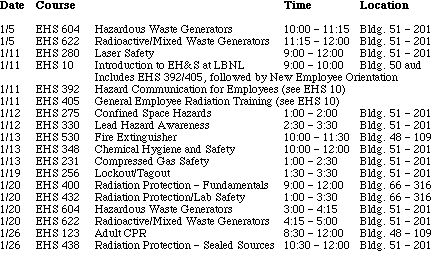
For more information or to enroll, contact Susan Aberg at Saberg@lbl.gov or enroll via the web at http://www-ehs.lbl.gov/ehstraining/registration/. Preregistration is required for all courses except EHS 10 (Introduction to EH&S). Times and locations are subject to change. For a full, updated schedule of EH&S training sessions see http://www-ehs.lbl.gov/schdeule/.
Seminars & Lectures
THURS., DECEMBER 21
PHYSICS DIVISION RESEARCH PROGRESS MEETING"Solving the Hierarchy Problem with an Extra Dimension and Seeing Gravitational Resonances at Colliders" will be presented by Raman Sundrum of Stanford University.
4:00 p.m., Bldg. 50A-5132
TUES., JANUARY 11
CENTER FOR ENVIRONMENTAL BIOTECHNOLOGY"Ecological Risk Assessment and the Design and Permitting of a Mixed Waste Treatment Facility" will be presented by William Smith, AGT Inc.
12 p.m., Bldg. 50A-5132
Holiday Shutdown Information
Berkeley Lab will shut down for the holidays starting Friday, Dec. 24. Please note that this season the break is being extended through Monday, Jan. 3, to provide the Lab's Y2K team additional time to work out any potential problems that may arise as a result of the Y2K issue. The Lab will reopen on Tuesday, Jan. 4.
For Thursday and Friday, Dec. 28 and 29, employees may use either vacation or leave without pay. New employees who have not accrued enough vacation may receive an advance against future accrual for these days. Should you choose to take leave without pay, make sure to request that option.
Friday, Dec. 24 -- Christmas Eve Holiday
Monday, Dec. 27 -- Christmas Day
Holiday
Tuesday, Dec. 28 -- Administrative Holiday
Wednesday, Dec. 29 --
Vacation or leave without pay*
Thursday, Dec. 30 -- Vacation or leave
without pay*
Friday, Dec. 31 -- New Year's Eve Holiday
Monday, Jan. 3 --
New Year's Day Holiday
The complete text of the Laboratory's policy on holidays may be found in Regulations and Procedures Manual ß2.10, located on the web at http://www.lbl.gov/Workplace/RPM/R2.10.html.
The holiday shutdown also offers a significant opportunity for energy cost savings, which are realized provided employees shut down equipment and utilities.
A minimum work forces will continue the following functions during the shutdown, including plant maintenance technicians, the Fire Department, and staff responsible for environmental protection, radiation assessment, animal care, and mail. Special programmatic needs may require additional employees to work during the shutdown.
All employees who work during the shutdown period must have advance approval by their division director.
Those who do work during the shutdown period can contribute to the energy savings by setting back thermostats in their workspace; shutting off nonessential lights and equipment; using small portable heaters and work station lighting; and keeping outside windows and doors closed
Have a happy and safe holiday!
UC Berkeley and Local Cities Sponsor Bay Area Book Drive for Children
To help young students improve their reading skills, UC Berkeley and the cities of Berkeley, San Francisco, Oakland, and Richmond, are sponsoring a children's book drive this holiday season. Bay Area residents are being asked to donate new children's books which will be used in UC Berkeley's AmericaReads literacy program. This program serves low-income elementary school students in the Berkeley, Oakland, San Francisco and West Contra Costa school districts.
UC Berkeley Chancellor Robert M. Berdahl was joined by mayors Shirley Dean, Willie Brown, Jerry Brown, and Rosemary Corbin in supporting this book drive, which is now underway and continues through Jan. 8, 2000. At the end of the school year, the new books will be given to students as achievement awards. The AmericaReads program is run by UCB's Berkeley Pledge program, a partnership between the campus and Bay Area school districts.
Donated books may be dropped off at Chancellor Berdahl's office at 200 California Hall or at the administrative offices of any of the school districts served by the Berkeley Pledge's AmericaReads program. In addition, new books and book certificates may be ordered online and shipped to the Berkeley Pledge offices through Amazon.com. Link to www.chance.berkeley.edu/bpledge and follow the instructions. Barnes and Noble in Berkeley is also offering a 10-percent discount on books purchased for the Berkeley Pledge Children's Book Drive.
Currents Online
The full text and photographs of each edition of Currents are published online at http://www.lbl.gov/Publications/Currents/. The site allows users to do searches of past articles dating back to 1994.
Flea Market
Autos / Supplies
`98 HONDA Passport EX, 4 wd, 3.2L V6, like new, less than 8K mi, silver metallic, 5 CD changer, 6 stereo speakers, pwr sunrf/windows/locks, sec system, remote keyless entry, silver alloy wheels, $24,750/bo, Charles, X6031, (925) 682-3269 (evenings)`97 HONDA Civic HX, 5 spd, ext warranty, exc cond, VTEC engine, silver metallic, remote entry, alarm, alloy wheels, ac, pwr steer/wndw/lock, 51K mi, am/fm/cass, $11,500/bo, Ronald, X4213, 339-1176
`94 TOYOTA Previa, $12,450, 119K mi, Captain's chairs, CD, privacy glass, silver ext, gray int, all mainten records avail, Mike, X6458, Harold, (415) 973-6725
`94 FORD Taurus, 56K mi, 4 dr, sedan, alarm, ac, abs, cruise, $6,900, Peter, X5983, Patricia, (925) 687-1827
`92 FORD Escort Wagon, 94K mi, auto trans, am/fm, ac, exc cond, full maint doc avail, orig owner, no accidents, $3,200, Alex, X6849, (925) 945-1131
`87 DODGE Colt E sedan, 5 spd, 4 dr, am/fm/cass, 148K mi, runs great, $1,200/bo, Andre, X5600, 486-2383
`87 NISSAN Maxima GXE, 4 dr, sunrf, 2-tone gray, 112K mi, $3,500, Art, 237-4654
`81 VOLVO 240 DL sedan, 112K, auto, sec owner, all records, well cared for, tan, sunrf, runs great, $1,350, Karen, X7489
`68 CHEVY Nova, straight 6 engine, at, runs, exc body cond, all original, $1,800, Tim, (925) 687-0405
Motorcycle
`86 HONDA MAGNA V45, 700cc, 23K, very clean, runs great, 150 PSI compression, new tires/seat/battery/fork seals, $1,800, Garry, 486-5721`87 KAWASAKI VULCAN VN1500-B, 22k, metallic blue, super clean, new tires/seat, performance pipes, $2,300, Garry, 486-5721
Housing
BERKELEY, 2 bdrm apt in duplex near Alta Bates Hospital; newly renovated kitchen, beautiful hardwd flrs, fireplace, study-nook, suitable for mature professional couple, $1,800/month, Lara, X7276, Joy (925) 254-8754BERKELEY, recently restored 2 bdrm house,15 mins walk west of downtown, furn, share yard/laundry, $1,900/mo, 486- 7028, 848-2389
BERKELEY HILLS, room for rent in private home on Euclid/Cedar, 5 blocks from campus, fully furn, kitchen, laundry, deck, view of SF/Golden Gate/bay, close to transp, shops, tennis courts, rose garden, lab shuttle, non-smoking, no pets, must be clean, prefer visiting scholar or FT working person, share w/ 2 visiting scholars, $600/month + util, 841-2749
BERKELEY PARK HILLS house in wooded neighborhood, furn, 3 bdrms/2 baths, large kitchen, living/dining/study, private yard, avail 2/12 - 9/2000 (longer lease possible), Gisela, 841-2066
ELMWOOD, share elegant 11 rm house w/ 2 men, 1 woman, non-smoking professionals, $600/month + deposit, shared exp, medium bdrm with walk-in closet, built-ins, piano, yellow Labrador, laundry, sauna, hardwd floors, exc neighborhood, woman pref, Tony, 841-5424
WEST BERKELEY, private room for rent in charming home, shared bath/kitchen, easy transport to LBNL, ideal for short-term visitors and researchers, $600/month, Ted, X4203, Cloe, 848-4104
OAKLAND, share sunny, older, upper flat in Piedmont Ave area w/ one female LBNL researcher, close to 51 bus, Rockridge/ MacArthur BART, 3 bdrms, full living/dining rms, front/back yards, balconies in common area, view, laundry, dishwasher, piano, 2 cats, $500/mo, short/ long term, avail 12/1, Judy, 654-6994, X5154
EL CERRITO, nice, well furn room in house for single visiting scholar, grad student, located in a quiet, excellent area, avail 2/2000, 4 miles from school, near bus stop, BART, shopping ctr; tv, private phone, laundry, street parking, non-smoker, no pets/live-in guests, $485/month + util, $600 deposit, Keller, 524-2780
Miscellaneous
3-in-1 BUMPER POOL TABLE, exc cond, $150, Mary, X7461, Don, 582-3079, 538-7900BABY STUFF, Graco Play-n-Pack bassinette/play yard, $45, folds, transports and sets up easily; Evenflo On My Way travel system, $70; rear facing baby carrier/car seat that mounts onto matching Baby Bjorn baby carrier, $25, Vicki, 215-5708
CAMERA, Canon EOS Elan, 28-80mm, zoom lens, auto focus $375; classical guitar, 1977 Ramirez 2A, 664 mm scale length, cedar top/Brazilian rosewood back/sides, mint cond, $3,500, Steve, X6228, (925) 377-8524
COMPUTER GAME, Myst for Macintosh, on CD, never opened, $10, Jon, X5974
DRAGON TREE (Dracaena marginata), 2 stems, 5 ft to tip of tallest spike, free if you pick up, $5 otherwise, Linda, X4787, 245-3401
EXERCISE MACHINE, CardioFit, electronic monitor, as-new cond, $75/bo, Ian, X4174, 548-7102
G-1 USN ISSUE, leather flight jacket, men's size 40 reg, brown, exc used cond, $150, Bob X6180, (925) 556-1501
GLASS TABLE and four slate blue velour chairs, $50; hamster habitrail with accessories $20; Aprica double stroller, $125; Century infant car seat, $15; Graco battery infant swing, $20; Peter or Patricia, (925) 687-1827
MOUNTAIN BIKE, women's, Trek 800, Shimano Altus C20, racing green, very good cond, (new $600), $300, Jan, X6676
OPERA TICKETS, SF, La Boheme, 1/14, balc circle ctr, $150/pair, Diana, X6444
ROSSIGNOL 4S SKIS, size 207cm, need new bindings, $80; queen size futon used 1 month, $90; papasan chair, round bamboo with dark green pad, $30; glass side table, metallic gold legs, $15; large rectang mirror, unframed approx 4' by 3', $25; 2 sets of Japanese blinds, white paper w/ black wood, 6' high, $15 each; computer printer table, simulated wood finish, $15, Scott, X4874
SANYO stereo system, 10 yrs old, in good cond, turntable, tuner, tape deck (tape deck #1 not working, #2 is fine), speakers, $20/bo, Melissa, 665-5572, leave msg
WOOD DOORS, 7 interior solid wood, most paneled, 24 to 32" wide; 1 exterior, 36" wide, make offer, Guy, X4703, 482-1777
YAMAHA P22 Studio acoustic piano, oak, exc cond, $2,300/bo, Steve, 655-8379
Wanted
HOUSING from Jan/Feb 2000 for 1 or 2 years for postdoc, spouse + 2 children from Germany, pref furn, 2 or 3 bdrms/2 baths, yard, Artur, 528-8395, X7257POSTDOC seeks people willing to carpool from Davis to UCB or LBNL, 5 days/week, 9 am to 6pm, willing to flex hours +/- 30 min, X4663, (530) 757-6375
SLIDE PROJECTOR, slide trays, Jan, X6676
CONSOLE or upright piano for beginner, Peter or Patricia, (925) 687-1827
COMPUTER MEMORY, 16 MB Techworks, DIMM, factory sealed bag, lifetime guaranty, can be used in Power Macs/other computers, $35, H. Matis, X5031, 540-6718
Vacation
SO LAKE TAHOE, spacious chalet in Tyrol area, close to Heavenly, peek of lake from front porch, fully furn, sleeps 8+, sunny deck, pool, spa in club house, close to casinos, shopping, more, Pat or Maria, 724-9450TAHOE KEYS at So Lake Tahoe, house, 3 bdrm/2.5 bth, fenced yard, quiet area, close to attractions, skiing nearby, great views, $150/night (2 nights min), Bob (925) 376-2211
Lost & Found
FOUND: Silk scarf, blue flowers, in Bldg. 70A women's bathroom in Nov, Nan, 524-5185Note: For other lost and found items call X4855.
Flea Market Ad Policy
Ads are accepted only from LBNL employees, retirees, and on-site DOE personnel. Only items of your own personal property may be offered for sale.
Submissions must include name, affiliation, extension, and home telephone number.
Ads must be submitted in writing--via e-mail (fleamarket@lbl.gov), fax (X6641), or delivered/ mailed to Bldg. 65B. No ads will be taken by phone.
Ads will run one issue only unless resubmitted in writing. They will be repeated only as space permits.
The deadline for the Jan. 17 issue is 5 p.m. Friday, Jan. 10.
